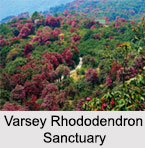 The Versey Rhododendron Sanctuary is situated in Western Sikkim. The sanctuary is located in the Singalila Range that forms a natural border with Nepal in the West. Singalia Range is acclaimed to be the leading area of rhododendrons. Varsey is a small town in the north-eastern state of Sikkim in India. Varsey has been popular for its Rhododendron Sanctuary. The Rhododendron Sanctuary also borders the State of West Bengal from Sikkim in the south by Rambong Khola stream. The Versey sanctuary is spread over 104 sq. km. The Varsey Sanctuary can be reached from three points- Hilley, Dentam and Soreng.
The Versey Rhododendron Sanctuary is situated in Western Sikkim. The sanctuary is located in the Singalila Range that forms a natural border with Nepal in the West. Singalia Range is acclaimed to be the leading area of rhododendrons. Varsey is a small town in the north-eastern state of Sikkim in India. Varsey has been popular for its Rhododendron Sanctuary. The Rhododendron Sanctuary also borders the State of West Bengal from Sikkim in the south by Rambong Khola stream. The Versey sanctuary is spread over 104 sq. km. The Varsey Sanctuary can be reached from three points- Hilley, Dentam and Soreng.
Climate of Varsey
Varsey sanctuary having an altitude of over 10,000 feet witnesses a prevailing wet and cold climate in most part of the year. This climate helps in the growth of alpine forest predominantly oaks, magnolia and rhododendron. The sanctuary receives an annual precipitation of 250 cm. The upper ridges in the sanctuary receive regular snowfall during winter between December and February. April and May observe the sanctuary blooming with rhododendron flowers.
Flora and Fauna in Varsey Rhododendron Sanctuary
The Varsey Sanctuary is a home to several species of Rhododendron, Primula, Magnolia, oaks and pine. The entire region is covered with dense primitive forest. Other species that are also found here are rboreum, cinnabarinum, falconeri, barbatum, campanulatum hodgsoni, Acer caudatum, Betula utilis, Pieris ovalifolia, Prunus rufa, Pyrus foliolosa and P. macrophylla. Here, Bamboo and varieties of shrubs can also be observed.
The Varsey Sanctuary is also famous for rare Himalayan species like Red Panda and Black Bear. Leopard, Leopard Cat, Marbled Cat, Himalayan Yellow Throated Marten, Himalayan Palm Civet, Cannidae Wild dog, Indian Fox, Jackal, Himalayan Black Bear, Wild Boar, Barking Deer, Serow, Assamese Macaque, Rhesus Macaque, Himalayan Langur, Crimson Horned Pheasant, Monal Pheasant and Kaleej Pheasant, Crestless Porcupine, Rufous Tailed Hare, Chinese Pangolin, Flying Squirrel, Giant Squirrel and Himalayan Mouse Hare are some of the faunal values of Barsey Sanctuary.
Visiting Information to Varsey Rhododendron Sanctuary
The best time to visit the sanctuary is between the months of November and May. During this time the sky remains clear and the tourists can enjoy the best mountains view. The sanctuary can be reached from Siliguri or New Jalpaiguri via Jorethang.



















